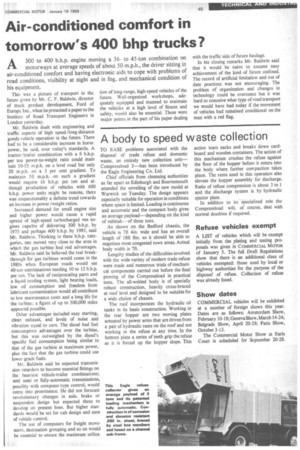A body to speed waste collection
Page 47

If you've noticed an error in this article please click here to report it so we can fix it.
TO EASE problems associated with the disposal of trade refuse and domestic waste, an entirely new collection unitCompressload 3—has been introduced by the Eagle Engineering Co. Ltd.
Chief officials from cleansing authorities as far apart as Edinburgh and Bournemouth attended the unveiling of the new model at Warwick on Tuesday. The design appears especially suitable for operation in conditions where space is limited. Loading is continuous and automatic and the compact body gives an average payload—depending on the kind of rubbish—of three tons.
As shown on the Bedford chassis, the vehicle is 7ft 4in. wide and has an overall length of 18ft 8in. so it should be able to negotiate most congested town areas. Actual body width is 7ft.
Lengthy studies of the difficulties involved with the wide variety of modern trade refuse were made and numerous trials of mechanical components carried out before the final proving of the Compressload in practical tests. The all-welded body is of specially robust construction, heavily cross-braced at roof level and designed to be suitable for a wide choice of chassis.
The roof incorporates the hydraulic oil tanks in its basic construction. Working in the rear hopper are two moving plates actuated by power arms that are driven from a pair of hydraulic rams on the roof and not working in the refuse at any time. In the bottom plate a series of teeth grip the refuse as it is forced up the hopper slope. This
action tears sacks and breaks down cardboard and wooden containers. The action of this mechanism crushes the refuse against the floor of the hopper before it enters into the body where further compaction takes place. The rams used in this operation also elevate the hopper assembly for discharge. Ratio of refuse compression is about 3 to 1 and the discharge system is by hydraulic ejector plate.
In addition to its specialized role the Compressload will, of course, deal with normal dustbins if required.
Refuse vehicles exempt
A LIST of vehicles which will be exempt initially from the plating and testing proposals was given in COMMERCIAL MOTOR of January 5. The full Draft Regulations show that there is an additional class of vehicles exempted: those used by local or highway authorities for the purpose of the disposal of refuse. Collection of refuse was already listed.
Show dates
COMMERCIAL vehicles will be exhibited at a number of foreign shows this year. Dates are as follows: Amsterdam Show, February 10-18; Geneva Show, March 14-24; Belgrade Show, April 20-28; Paris Show, October 3-13.
The Commercial Motor Show at Earls Court is scheduled for September 20-28.




















































































































